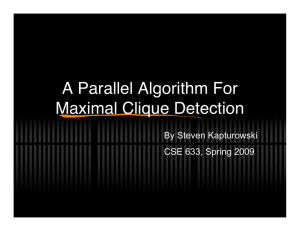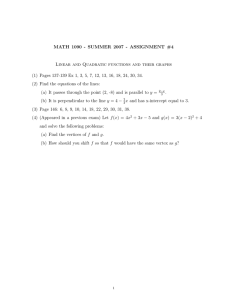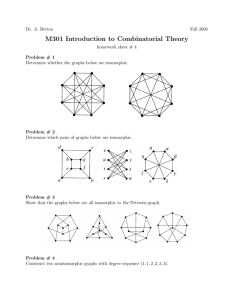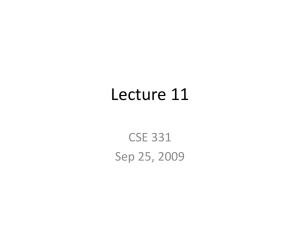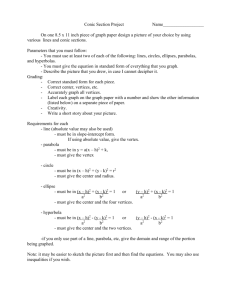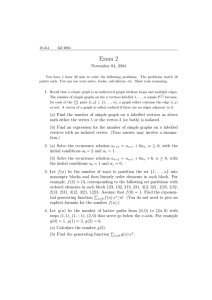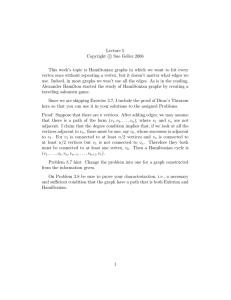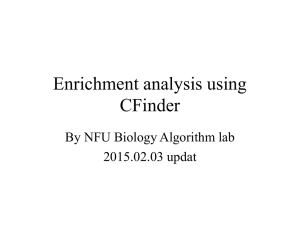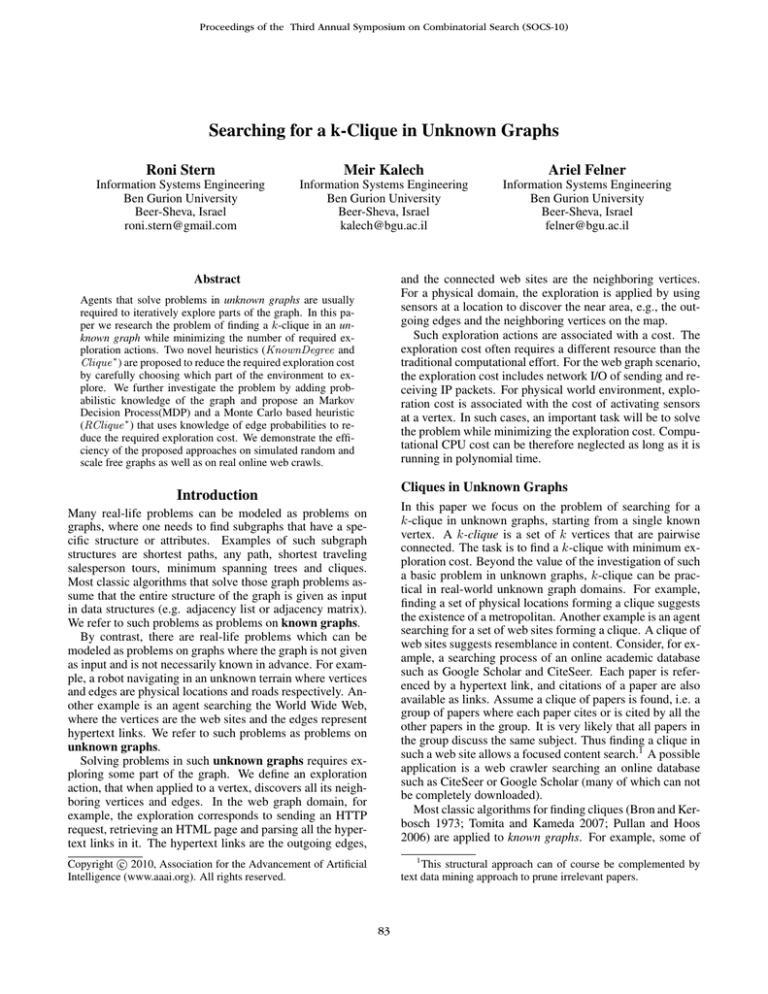
Proceedings of the Third Annual Symposium on Combinatorial Search (SOCS-10)
Searching for a k-Clique in Unknown Graphs
Roni Stern
Meir Kalech
Ariel Felner
Information Systems Engineering
Ben Gurion University
Beer-Sheva, Israel
roni.stern@gmail.com
Information Systems Engineering
Ben Gurion University
Beer-Sheva, Israel
kalech@bgu.ac.il
Information Systems Engineering
Ben Gurion University
Beer-Sheva, Israel
felner@bgu.ac.il
Abstract
and the connected web sites are the neighboring vertices.
For a physical domain, the exploration is applied by using
sensors at a location to discover the near area, e.g., the outgoing edges and the neighboring vertices on the map.
Such exploration actions are associated with a cost. The
exploration cost often requires a different resource than the
traditional computational effort. For the web graph scenario,
the exploration cost includes network I/O of sending and receiving IP packets. For physical world environment, exploration cost is associated with the cost of activating sensors
at a vertex. In such cases, an important task will be to solve
the problem while minimizing the exploration cost. Computational CPU cost can be therefore neglected as long as it is
running in polynomial time.
Agents that solve problems in unknown graphs are usually
required to iteratively explore parts of the graph. In this paper we research the problem of finding a k-clique in an unknown graph while minimizing the number of required exploration actions. Two novel heuristics (KnownDegree and
Clique ∗ ) are proposed to reduce the required exploration cost
by carefully choosing which part of the environment to explore. We further investigate the problem by adding probabilistic knowledge of the graph and propose an Markov
Decision Process(MDP) and a Monte Carlo based heuristic
(RClique ∗ ) that uses knowledge of edge probabilities to reduce the required exploration cost. We demonstrate the efficiency of the proposed approaches on simulated random and
scale free graphs as well as on real online web crawls.
Cliques in Unknown Graphs
Introduction
In this paper we focus on the problem of searching for a
k-clique in unknown graphs, starting from a single known
vertex. A k-clique is a set of k vertices that are pairwise
connected. The task is to find a k-clique with minimum exploration cost. Beyond the value of the investigation of such
a basic problem in unknown graphs, k-clique can be practical in real-world unknown graph domains. For example,
finding a set of physical locations forming a clique suggests
the existence of a metropolitan. Another example is an agent
searching for a set of web sites forming a clique. A clique of
web sites suggests resemblance in content. Consider, for example, a searching process of an online academic database
such as Google Scholar and CiteSeer. Each paper is referenced by a hypertext link, and citations of a paper are also
available as links. Assume a clique of papers is found, i.e. a
group of papers where each paper cites or is cited by all the
other papers in the group. It is very likely that all papers in
the group discuss the same subject. Thus finding a clique in
such a web site allows a focused content search.1 A possible
application is a web crawler searching an online database
such as CiteSeer or Google Scholar (many of which can not
be completely downloaded).
Most classic algorithms for finding cliques (Bron and Kerbosch 1973; Tomita and Kameda 2007; Pullan and Hoos
2006) are applied to known graphs. For example, some of
Many real-life problems can be modeled as problems on
graphs, where one needs to find subgraphs that have a specific structure or attributes. Examples of such subgraph
structures are shortest paths, any path, shortest traveling
salesperson tours, minimum spanning trees and cliques.
Most classic algorithms that solve those graph problems assume that the entire structure of the graph is given as input
in data structures (e.g. adjacency list or adjacency matrix).
We refer to such problems as problems on known graphs.
By contrast, there are real-life problems which can be
modeled as problems on graphs where the graph is not given
as input and is not necessarily known in advance. For example, a robot navigating in an unknown terrain where vertices
and edges are physical locations and roads respectively. Another example is an agent searching the World Wide Web,
where the vertices are the web sites and the edges represent
hypertext links. We refer to such problems as problems on
unknown graphs.
Solving problems in such unknown graphs requires exploring some part of the graph. We define an exploration
action, that when applied to a vertex, discovers all its neighboring vertices and edges. In the web graph domain, for
example, the exploration corresponds to sending an HTTP
request, retrieving an HTML page and parsing all the hypertext links in it. The hypertext links are the outgoing edges,
1
This structural approach can of course be complemented by
text data mining approach to prune irrelevant papers.
c 2010, Association for the Advancement of Artificial
Copyright Intelligence (www.aaai.org). All rights reserved.
83
expanded and Vgen ⊆ Vknown as the set of all the vertices
that have been generated but not expanded. A typical vertex
goes through the following stages. First it is unknown. Then
when it is generated, it is added to Vknown . Finally, when it
is expanded, its incident edges and its neighboring vertices
are added to Gknown .
Each exploration action has a corresponding exploration
cost which depends on the vertex:
these algorithms order the vertices by their degrees and then
start by accessing the vertex with the highest degree. Such
algorithms are not naturally applicable to unknown graph,
since in unknown graphs the degree of the vertices is unknown. There has been some preliminary work by Altshuler
et. al. (2005) on searching for a k-clique in unknown physical graphs. However, the focus of that work was on different
communication paradigms for multiple agents that search
for a k-clique in physical unknown graphs.
We introduce a general framework for finding a k-clique
in an unknown graph based on Best-First Search. This algorithm uses a heuristic to choose the next vertex to explore.
We present several such heuristics: The KnownDegree
heuristic which considers the highest degree of vertices on
the explored part of the graph. The Clique ∗ heuristic which
chooses vertices that are connected to a larger potential kclique. We propose two options to exploit probabilistic
knowledge of the graph, if such exists. An MDP formalization is presented, that allows calculating an optimal exploration policy and a more practical Monte-Carlo based
heuristic, named RClique ∗ .
We evaluated the exploration cost of the presented algorithms empirically on random graphs and scale free
graphs (Eppstein and Wang 2002; Bonato and Laurier 2004).
Additionally, we applied the different algorithms as part of
an online web crawler, searching for cliques of citations
in Google Scholar. All the above algorithms as well as a
baseline random exploration algorithm were compared. Results show that all algorithms are superior to the random
algorithm requiring less than 50% of the exploration cost.
Clique ∗ is shown to be usually better than KnownDegree,
and RClique ∗ is able to use the knowledge of the edge probabilities to significantly outperform Clique ∗ .
Definition 3 [Exploration Cost] The function exCost :
V → R obtains a vertex and returns its exploration cost.
The cost function is additive, meaning that the total cost of multiple exploration actions is the summation
over all the exploration costs of the explored vertices.
In this paper we assume a constant exploration cost C:
∀v ∈ V exCost(v) = C for some C. This is motivated
by a number of real world scenarios such as the following
examples. (1) a central controller that can be queried to provide the exploration data. (2) a robot that senses its nearby
environment where the sensing cost is constant. (3) querying a web page from a single host. For example, we have
measured the runtime required to query Google Scholar and
parse the resulting web page for its hypertext links.2 More
than 90% of the queries required approximately the same
amount of time (+-200 milliseconds). Without loss of generality, we will assume in the rest of the paper that C = 1
for simplicity. Now we can define the k-clique problem in
an unknown graph:
Definition 4 [k-clique problem in an unknown graph] Assume a graph G = (V, E), a constant k and an agent a
with the known graph Gknown ⊆ G, where Vgen = {s},
Vexp = ∅ and Eknown = ∅. Armed with Explore action,
the goal of a is to find a k-clique in G with a minimal exploration cost.
Problem Definition
Best-First Search Approach
The following definitions are required for the k-clique problem in unknown graphs.
Searching for a k-clique in unknown graphs is inherently an
iterative process, in which the graph is explored vertex by
vertex. Therefore, we propose a best-first search approach.
In every step the agent chooses the next target vertex to explore from Vgen . After exploring each vertex, we search for
a k-clique in Gknown . A simple brute force implementation
of a k-clique search in Gknown has a worst case computational complexity of O(|Vknown |k ). For small values of k
this is tractable. Note that this search for a k-clique does
not require any exploration cost, since Gknown contains the
part of the graph that has already been discovered. This
loop of selecting a vertex to explore, exploring it and testing
the known graph for a k-clique continues until a k-clique is
found or when all the vertices in the graph are explored. This
is equivalent to a best-first search where Vgen is the open-list
and Vexp is the closed-list.
The main challenge is how to choose the next vertex to
explore. In the worst case, all the vertices must be explored
(as explained above). However, we show that in practice,
an intelligent heuristic that determines the ”best” vertex to
Definition 1 [Known Graph] Given a graph G = (V, E)
and an agent a, the known graph Gknown ⊆ G represents
the part of the graph that is known to a, where Vknown ⊆ V
represents the known vertices and Eknown ⊆ (Vknown ×
Vknown ) ∩ E represents the known edges.
We define an exploration action for the agent which can be
operated on any vertex v ∈ Vknown . This exploration model
is inspired by the fixed graph model (Kalyanasundaram and
Pruhs 1994).
Definition 2 [Explore] The action Explore(v) adds the
edges connected to v to Eknown , and adds the neighboring
vertices of v to Vknown .
We call two vertices neighbors if there is an edge connecting them in G. We define the function neighbors(v) to
return the set of neighboring vertices of vertex v. For ease of
notation, we borrow the terms expanded and generated from
the classic search terminology in the following way. Applying an exploration action to a vertex will be referred to as expanding that vertex and generating its neighbors. We denote
Vexp ⊆ Vknown as the set of all the vertices that have been
2
Data was gathered from a single end-user running 2,400 different queries.
84
Definition 6 [Generated Common Neighbors]
Let Vm be a T
set of expanded vertices. Then
gcn(Vm ) = vi ∈Vm neighbors(vi ) ∩ Vgen
These definitions lead to the Corollary 1. We omit a formal proof of this Corollary due to space limitations. The
proof is based on the fact that if a group of vertices is a kclique then any subset of that group must also be a clique.
Corollary 1 A set of vertices Vm ⊆ Vexp , where |Vm | =
m < k − 1 is a potential k-clique if and only if (1) Vm is an
m-clique and (2) |gcn(Vm )| ≥ k − m.
For every vertex v ∈ Vgen we denote PC vk as the set of
all potential k-cliques VP C such that v ∈ gcn(VP C ). Let
VP C be the largest potential clique among PC vk and assume
|VP C | = x. If VP C is indeed a part of a k-clique in G then
in the best case all we need is to expand k − 1 − x vertices
to reveal the k-clique. This enables defining the following
cost function hc∗ (v) for every v ∈ Vexp which estimates the
remaining cost to complete a k-clique.
Figure 1: Example of the different heuristics.
explore next can greatly reduce the number of explored vertices. Such a heuristic should exploit the current knowledge
of the graph - Gknown - to determine which of the vertices
in Vgen has highest chances to lead to the closest k-clique.
Next we propose three such heuristics.
Non-Probabilistic Heuristics
Next we introduce two heuristics KnownDegree and
Clique ∗ which assume that only the initial vertex of the
graph is given. In the following section we propose a heuristic which utilizes probabilistic knowledge about the graph if
such is available.
Definition 7 [The Clique* cost function]
hc∗ (v) =
min
VP C ∈PC v
k
k − 1 − |VP C |
The Clique ∗ heuristic chooses to explore the vertex with
the lowest hc∗ from Vgen .3 Ties are broken using the
KnownDegree heuristic. Theorem 1 states that if vertex v is
chosen by Clique ∗ then hc∗ (v) is a tight lower bound on the
cost of exploring a k-clique.
Known Degree
A very common and effective heuristic used for the k-clique
problem in known graphs is to search vertices with high degree (Tomita and Kameda 2007). Vertices with a high degree are more likely to be a part of a k-clique, than vertices
with a lower degree (Bollobas and Erdos 1976). In addition,
since vertices with a higher degree have more neighboring
vertices, exploring them adds more edges and vertices to
Gknown . Since the real degree of a vertex in Vgen is not
known as it has not been explored yet, we consider its known
degree as the number of expanded vertices that are adjacent
to it. The KnownDegree heuristic chooses to explore the
vertex with the highest known degree in Vgen .
For example, consider the known graph in Figure 1. The
grayed vertices are the explored vertices, and the white vertices are the generated vertices (from which to choose the
next vertex to explore). Using KnownDegree, the next vertex that will be explored is G, since its known degree (=4) is
the highest among the generated vertices.
Theorem 1 Clique ∗ is an admissible heuristic. There is
no better admissible heuristic, i.e. if vertex v is chosen by
Clique ∗ then there is no admissible function h0 such that
h0 (v) > hc∗ (v).
Proof: Let Vm be a set of m vertices that are a potential
k-clique. Extending Vm to a k-clique requires connecting all
its vertices to (k − m) vertices that form a (k − m) − clique
and have not been explored yet. Exploring a (k − m)-clique
requires a minimum of k − m − 1 exploration actions. Thus
in the best case extending Vm to a k-clique requires an exploration cost of k − m − 1. Since a vertex v ∈ Vgen may be
connected to several potential k-cliques, a lower bound on
the exploration cost of finding a k-clique if v is explored, is
the minimum over the lower bound of the exploration cost of
extending each of the potential k-clique in PC vk . By definition, every potential k-clique can be extended to a k-clique
in a graph that is consistent with Gknown (see Definition 5).
Therefore after exploring a vertex v, a k − clique may be
explored in G after hc∗ (v) exploration steps. Thus no better
admissible heuristic can be created. In order to use Clique ∗ , PC vk must be computed for every
vertex in Vgen before choosing the next vertex to explore.
This can be done by maintaining a global list of potential
k-cliques, denoted by PC k . Every set of expanded vertices
that form a potential k-clique is stored in PC k . When a vertex is expanded, PC k must be updated as potential k-cliques
may be created or deleted. Expanding
a node with degree D
Pk−1 this will require updating i=1 Di ≈ O(Dk−1 ) potential
Clique*
The second heuristic relates to the size of the largest clique
that can be extended to a k-clique. This is called a potential
k-clique which is defined next along with supporting terms.
We then develop a heuristic that selects to explore the vertex
connected to the maximal potential k-clique.
[RONI:MODIFIED DEFINITION]
Definition 5 [Potential k-Clique] A set of vertices VP C ⊆
Vexp where |VP C | < k − 1 is a potential k-clique if there exists a graph G0 = (V, E) that can be extended from Gknown
(i.e., Gknown ⊆ G0 ) and VP C is part of a k-clique in G0 .
We define the following function that returns a set of vertices in Vgen such that each member of this set is a neighbor
of every vertex in VP C .
3
85
If PC vk is empty, then hc∗ = k − 1.
k-cliques in the worst case, as theoretically at least every
subset of nodes with less than k nodes can be a potential
k-clique. However, if the unknown graph is not extremely
dense then most sets of nodes will not be potential k-cliques
since a set of nodes is a potential k-clique only if it keeps
the conditions defined in Corollary 1. Thus for small values
of k, calculating Clique ∗ is feasible.
Figure 1 presents an example of this heuristic. The size of
the desired clique is 6. The next node that will be explored
using Clique ∗ is either H, I or J, as they are connected to
a potential k-clique of size three (nodes S,E and F ). Note
that (S, E, F ) is a potential k-clique because |(S, E, F )| +
|gcn(S, E, F )| ≥ 6 (since gcn(S, E, F ) is (H, I, J)).
iterating over large parts of the state space and require significant overhead. We have implemented LAO* and found
it to be inefficient, failing to produce an optimal policy in
reasonable time for very small graphs (over 10 nodes).
RClique*
In order to still exploit the probabilistic knowledge, we propose a Monte Carlo based sampling technique that combines Clique ∗ as a default heuristic and sampling of the state
space. We call this heuristic Randomized Clique∗ or in short
RClique ∗ . This heuristic samples states from the MDP state
space described above, using the probabilistic knowledge of
the graph to generate the sampled states. Like Clique ∗ and
KnownDegree, RClique ∗ is invoked when choosing which
vertex to explore next and chooses to explore the vertex with
the lowest heuristic value. The RClique ∗ heuristic is designed to approximate the expected exploration cost based
on samples of the MDP state space described above.
Algorithm 1 presents the pseudo code for RClique ∗ . The
RClique ∗ heuristic requires the following two parameters :
(1) M axDepth specifies the maximum depth of every sample and (2) NumOfSampling specifies the number of samples to construct. In each sample, G0known and G0gen are
initialized by Gknown and Ggen (lines 3–4 in Algorithm 1).
Then a vertex v 0 is chosen (from G0gen ) for simulated exploration using the Clique ∗ heuristic (line 6). A simulated exploring action (SimulatedExplore) is then performed (line
0
0
7), removing v 0 from Vgen
and updating G0known and Vgen
0
0
by adding an edge between v and every other vertex in Vgen
with probability p, where p is the edge probability known
to the agent. This process continues until either a k-clique
has been found in G0known or after M axDepth iterations
have been performed. If a k-clique has been found after d
simulated exploration actions, the value stored for this sample is d (line 10). If the maximum depth has been reached
but no k-clique was found, then the default hc∗ is added to
d, to provide a heuristic estimating of the remaining exploration cost (line 11). Finally, the average sample value is returned (line 13). This value represents an approximation of
the expected exploration cost of choosing to explore vertex
v. Note that the agent does not have any knowledge of vertices that are not in Vknown . Therefore, since all the edges
connected to vertices in Vexp are already known, the simulated exploration in SimulatedExplore adds edges only
between vertices in Vgen .
Generating a random state (line 7) requires O(|Vgen |)
computational steps in the worst case - checking if the “explored” vertex is connected to every other generated vertex.
Checking if the new state contains a k-clique requires O(dk )
steps, where d is the degree of the “explored” node. This is
repeated for a maximum of M axDepth×NumOfSampling
times. In the worst case, RClique ∗ is applied for every
node in the graph (when no k-cliques exists). Therefore
the total computational complexity of RClique ∗ is O(|V | ·
M axDepth · NumOfSampling · dk ).
RClique ∗ has several features. It uses the probabilistic
knowledge to generate the states during the sampling (line
7). It utilizes Clique ∗ when choosing the target vertex during the sampling (line 6) and in estimating exploration cost
Probabilistic Heuristic
In many domains the exact searched graph is unknown but
there is some knowledge on the probability of the edges. For
example, if the searched graph is the world wide web then it
is well-known that it behaves like a scale free graph in which
the degree distribution of the graph vertices follows a power
law (i.e. the probability of a vertex having a degree x is xβ
for some exponent β) (Bonato and Laurier 2004). Another
example that is common in Robotics is a navigator robot in
an environment represented by a graph. The robot may have
an imperfect vision of the environment which could be represented as an error probability on the existence of an edge in
the graph (Thrun, Burgard, and Fox 2005). In such cases, it
seems that exploiting edge probabilities should significantly
affect the choice of which vertex to explore next.
By adding probabilistic knowledge, the problem of
searching for a k-clique in an unknown graph G = (V, E)
can be modeled as a finite-horizon Markov Decision Problem (MDP) (Puterman 1994) as follows: The states are all
possible pair combinations of (Gknown , Vgen ) (of all possible graphs and sets of nodes). The actions are the exploration actions applied to a node in Vgen . The transition function between two states (old and new state) is affected by the
existence probability of edges that were explored in the new
state. Finally, the reward of every action is -1 (corresponding
to the exploration cost of a node). The policy is to determine
in each iteration which node to choose. An optimal policy
minimizes the expected cost.
If an upper bound to the number of nodes in the unknown graph is known then it is theoretically possible to
employ an MDP solver such as Value Iteration or Policy Iteration (Howard 1960) to solve the problem optimally. Unfortunately, the size of the MDP state space grows doubly
exponentially with the number of vertices in the graph, as it
contains all possible subgraphs of G. For example, a graph
with 10 vertices requires O(10!245 ) MDP states: 10! for every possible order of exploring the 10 vertices, and 245 for
all the possible graphs with 10 vertices (an undirected graph
with 10 vertices has at most 10·9
= 45 edges). This pro2
hibits techniques that require enumerating all of the states
such as Value Iteration, Policy Iteration. A possible alternative is to use LAO* (Hansen and Zilberstein 2001), which
finds the optimal solution without searching all the possible states. However it is known that LAO* usually requires
86
Algorithm 1: RClique* cost function
1
2
3
4
5
6
7
8
9
10
11
12
13
Input: v, Explored vertex
Input: k, Size of desired clique
Input: M axDepth, Max sample depth
Input: NumOfSampling, Number of samples
Output: The expected exploration cost
r←0
for i=1 to NumOfSampling do
G0known ← Gknown
0
Vgen
← Vgen
for d=1 to M axDepth do
0
v 0 ← chooseN ext(Vgen
)
0
SimulatedExplore(v 0 , G0known , Vgen
)
0
if hasClique(k,Gknown ) then break
end
r ←r+d
if hasClique(k,G0known )=False then r ← r + hc∗ (v 0 )
end
return r/NumOfSampling
Figure 2: Non probabilistic heuristics on random graphs.
KnownDegree and Clique ∗ . We varied the vertex degree
(8,12,16) and the searched k-clique (5,6). Each combination
was simulated for 100 times on random graphs of various
size. The x-axis displays the number of vertices in the graph
and the y-axis displays the average of the exploration cost.
Since similar results were obtained for all 6 combinations,
our data points are the average of the 600 cases.
As can be seen, both heuristics proposed in this paper,
KnownDegree and Clique ∗ , outperform the random approach, amounting to a reduction of more than 60%(!) of
the total exploration cost. On the other hand, as the graph
size grows the difference between the lower bound of the
total exploration cost (computed by the optimal offline algorithm described above) and the total exploration cost of both
heuristics increases. Another observation is that the Clique ∗
heuristic is more effective than KnownDegree for random
graphs. This difference between the two heuristics increases
as the number of vertices in the graph grows, achieving a
reduction of 30% in random graphs with 750 vertices.
We also performed the same experiments on scale-free
graphs. The results displayed two interesting phenomenas. First, the reduction in the exploration cost of our
heuristics over the random approach grows significantly to
more than 80%. Second, the superiority of Clique ∗ over
KnownDegree heuristic becomes insignificant (we used
standard t-test). The reason for this result is that in scale
free graphs, there are several ”‘hub”’ vertices that have very
high degree, and many vertices with very low degree (this
creates the power law effect on the vertex degrees). Thus,
exploring nodes with high degree is more likely to gain more
knowledge of the graph.
in case the maximum depth has reached (line 11). In addition, it is an anytime algorithm: one can always add more
samples in order to improve the average sample cost.
Experimental Results
We empirically compared the different heuristics by running
simulations on various graphs. We varied (1) the size of
the graphs, (2) the graph structure, (3) the initial state and
(4) the desired clique size (k = {5, ..., 9}). We compared
our heuristics to a baseline algorithm, in which the agent
chooses randomly which vertex to explore next. In addition,
for every particular problem instance the optimal offline exploration cost was calculated (assuming full knowledge of
the graph). The optimal cost is the shortest path from the
initial vertex to the closest k-clique plus the exploration cost
of exploring that clique (k − 1). Clearly no algorithm can do
better than that, and thus it is a lower bound on the exploration cost of an optimal algorithm.
Simulated Graphs
We experimented with simple random graphs and scale free
graphs. In random graphs the probability that an edge exists between any two vertices in the graph is constant. These
graphs have been extensively used in many computer science problems as an analytical model and as benchmarks
for evaluating algorithm efficiency. In scale free graphs the
degree distribution of the vertices can be modeled by power
laws, i.e. p(degree(v) ≥ x) = x−β , β ≥ 1. Many networks, including social networks and the Internet exhibit
a degree distribution that can be modeled by power laws.
Since one of the domains which we are interested is the Internet, it seems natural to run experiments on this class of
graphs as well. There are several scale free graph models.
In this paper we focused on graphs generated by the graph
model of Eppstein and Wang (2002) due to its simplicity.
In Figure 2 we compare the average total exploration
cost on random graphs of the non-probabilistic heuristics,
Simulated Graphs with Probabilistic Knowledge
RClique ∗ assumes that probabilistic knowledge about the
existence of an edge connecting two vertices in Vgen is
available. To empirically evaluate RClique ∗ we simulated
this probabilistic knowledge by a priory defining a probability for every possible edge between generated nodes, i.e.,
∀e = (v1 , v2 ), v1 , v2 ∈ Vgen , P (e ∈ E) = [0, 1] is known.
To determine different levels of uncertainty for an entire test configuration, we defined a variable noise that determines the maximum uncertainty of a single edge. For
every possible edge e the agent is given P (e ∈ E) =
1−rand(0, noise) if e ∈ E or P (e ∈ E) = rand(0, noise)
87
Figure 3: Random graphs, various levels of noise.
otherwise, where rand(a, b) is a random number uniformly
distributed between a and b. Clearly if noise = 1 the agent
has random knowledge about the existence of edges in G.
We ran experiments for RClique ∗ approach using 250
samples and a depth of 3 and various levels of noise. Figure 3 shows the average exploration cost of searching for a
5-clique in a graph of 100 vertices and 800 edges. The y-axis
shows the average exploration cost. The bars denote the different heuristics, including (1) KnownDegree, (2) Clique ∗ ,
(3) RClique ∗ with various levels of noise (0%, 25%, 50%),
(4) random approach and (5) the lower bound provided by
the optimal offline algorithm. As expected, an agent with
less noise achieves a lower exploration cost. However, even
with a setting of 50% noise RClique ∗ outperforms Clique ∗
by a factor of almost 2. We have also evaluated the effect of
different sampling depths on a RClique ∗ heuristic using 250
samples and 50% noise. Depth 1,2,3,4 and 5 yielded an exploration cost that was 5.34, 4.15, 2.65, 2.52, 2.32 times the
lowerbound respectively. Thus it seems that while deeper
sampling reduces the exploration cost of the search, there is
no substantial reduction beyond depth 3.
Figure 4: Citation web graph from a random walk in GS.
Algorithm
Random
KnownDegree
Clique ∗
Cost
62.73
54.73
13.23
4-clique
Runtime Ratio
68.64
1.09
28.59
0.52
15.68
1.19
Found
15
14
22
Algorithm
Random
KnownDegree
Clique ∗
Cost
101
82.91
41.86
5-clique
Runtime Ratio
99.86
0.99
44.59
0.54
48.55
1.16
Found
0
6
17
Table 1: Online search results of the GS web citation graph.
an example of the webgraph generated by a random crawl,
starting with a GS query of “Sublinear Algorithms”.
We have performed 25 such random walks, starting from
different queries of 25 computer science topics, and generated 25 corresponding citation web graphs. As could be
expected, the resulting graphs exhibit a power law distribution of the node degrees. Interestingly, many of the citation
web graphs contained 4-cliques (95%) and 5-cliques (70%).
On the other hand, very few (25%) contained larger cliques.
Note that every random walk was halted after exploring several hundreds of nodes, and larger cliques may be found by
further exploration.
Table 1 presents the results of 22 online GS web crawls,
performed using each of the non-probabilistic heuristics and
the random baseline. Each web crawl was halted after
exploring 100 web sites. We used computer science related terms (e.g. ”Subgraph-Isomorphism”, ”Online Algorithms”) to start the crawl in GS. The Cost column represents
the number of nodes explored until a k-clique was found and
the ’Runtime’ column represents the runtime in seconds. If
after exploring 100 web sites the desired clique had not been
found, a cost of 101 was set. The Ratio column displays the
average number of seconds required to explore a node (Runtime divided by Cost). The column Found represents the
number of crawls in which the k-clique has been found.
Clearly Clique ∗ requires exploring significantly fewer
nodes than both KnownDegree and Random. Much
more 5-clique were found with Clique ∗ in comparison
Real Unknown Graphs from the Web
We have built an online search engine designed to search for
a k-clique in a real graph - the web. Specifically, we implemented a web crawler designed to search for a k-clique in
academic papers available in Google Scholar web interface
(denoted hereafter as GS). Each paper found in GS represents a node, and citations between papers represents the
edges. We call the resulting graph the citation web graph.
Naturally, the connection in context between papers is bidirectional (although two papers can never cross cite each
other), thus we model the citation web graph as an undirected graph. The motivation behind finding cliques in the
citation web graph is to find relevant significant papers discussing a given subject (as discussed in the introduction).
This can be done by starting the clique search with a query
of the desired subject.
The web crawler we implemented operated as follows. An
initial query is sent to GS. The result is parsed and a list
of hypertext links referencing academic work in GS is extracted. The crawler then selects which link to crawl to next,
and follows that link. The resulting web page is similarly
parsed for links. This process is repeated until a k-clique
is found. First we ran the crawler with random walk, i.e.,
choose randomly which link to explore next. Figure 4 shows
88
Acknowledgments
with KnownDegree (17 vs. 6), exploring on average half
of the nodes. However, due to the large overhead required in Clique ∗ the difference in runtime is not large
(KnownDegree is even faster for 5-cliques). Performing a
larger scale online experiment is beyond the scope of this
work, as it requires leasing wide Internet bandwidth.
Consider the results in the Ratio column of Table 1, which
are the the ratio between the search runtime and the number of explored nodes. For example, when searching for
a 4-clique, the average number of seconds required to explore a node was 1.1 for Random, 0.52 for KnownDegree
and 1.19 for Clique ∗ . The slow runtime per node exhibited by Clique ∗ can be explained by the additional runtime
of running Clique ∗ in comparison with KnownDegree and
Random which requires only O(1) operations to choose
the next node to explore. The difference in the runtime
per node between KnownDegree and Random can be explained by the runtime required to search for a k-clique in
the known part of the graph (Gknown ). As more nodes are
explored, Gknown grows, demanding more time to search
for a k-clique. The fact that KnownDegree finds a k-clique
by exploring less nodes than Random (54.73 as opposed to
62.73 for 4-clique), explains the larger runtime per node of
Random. A crucial part of the search runtime is due to the
time required to fetch a web page from the Internet. This
introduces significant variability to the runtime results, as
the time needed to fetch a web page depends on the location
of the web page in the Internet and the state of the Internet
route to it at the time that it is fetched. Thus it is not possible
to analyze the runtime per node conclusively with a dataset
that contains only 22 instances.
This research was supported by the Israeli Science Foundation (ISF) grants No. 728/06 and 305/09
References
Altshuler, Y.; Matsliah, A.; and Felner, A. 2005. On the
complexity of physical problems and a swarm algorithm for
the k-clique search in physical graphs. ECCS.
Bollobas, B., and Erdos, P. 1976. Cliques in random graphs.
In Math. Proc. Camb. Phil. Soc., 419–427. Great Britian:
MPCPS.
Bonato, A., and Laurier, W. 2004. A survey of models of
the web graph. In CAAN, 159–172.
Bron, C., and Kerbosch, J. 1973. Algorithm 457: finding all
cliques of an undirected graph. Commun. ACM 16(9):575–
577.
Eppstein, D., and Wang, J. 2002. A steady state model for
graph power laws. In In 2nd International Workshop on Web
Dynamics.
Hansen, E. A., and Zilberstein, S. 2001. LAO*: A heuristic
search algorithm that finds solutions with loops. Artif. Intell.
129(1-2):35–62.
Howard, R. A. 1960. Dynamic Programming and Markov
Processes. Cambridge, MA: MIT Press.
Kalyanasundaram, B., and Pruhs, K. R. 1994. Constructing competitive tours from local information. Theoretical
Computer Science 130(1):125–138.
Pullan, W., and Hoos, H. H. 2006. Dynamic local search for
the maximum clique problem. Journal of Artificial Intelligence Research 25:159–185.
Puterman, M. L.
1994.
Markov Decision Processes: Discrete Stochastic Dynamic Programming. WileyInterscience.
Thrun, S.; Burgard, W.; and Fox, D. 2005. Probabilistic Robotics (Intelligent Robotics and Autonomous Agents).
The MIT Press.
Tomita, E., and Kameda, T. 2007. An efficient branch-andbound algorithm for finding a maximum clique with computational experiments. J. of Global Optimization 37(1):95–
111.
Conclusion and Future Work
In this paper we have analyzed the k-clique problem in unknown graphs. A best first search framework was proposed,
with two non-probabilistic heuristics, KnownDegree and
Clique ∗ . RClique ∗ heuristic has been presented that utilizes
edge probability knowledge if available. Empirical evaluation has shown that these heuristics achieve substantial reduction in exploration cost.
There are many open questions and future directions. We
intend to perform a large scale online crawling using the proposed algorithms, combining the clique search with a content based textual data mining. Moreover, this paper has focused on a special pattern - a clique. We intend to generalize
the approaches presented in this paper to solve the general
subgraph isomorphism problem in unknown graphs. Additionally, we intend to research more complex exploration
cost model, such as a physical based model in which exploring a node requires an agent to move to its geographic
location. Multiple agents collaborating in unknown graphs
is another interesting future direction.
89

